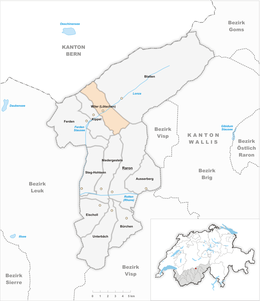Wiler
| Wiler (Lötschen) | ||
|---|---|---|
 |
||
|
||
| Coordinates: 46°23′N 7°46′E / 46.383°N 7.767°ECoordinates: 46°23′N 7°46′E / 46.383°N 7.767°E | ||
| Country | Switzerland | |
| Canton | Valais | |
| District | Raron | |
| Area | ||
| • Total | 14.66 km2 (5.66 sq mi) | |
| Elevation | 1,421 m (4,662 ft) | |
| Population (Dec 2015) | ||
| • Total | 576 | |
| • Density | 39/km2 (100/sq mi) | |
| Postal code | 3918 | |
| SFOS number | 6202 | |
| Surrounded by | Blatten (Lötschen), Kandersteg (BE), Kippel, Niedergesteln, Raron | |
| Website |
website missing SFSO statistics |
|
Wiler (Lötschen) is a municipality in the district of Raron in the canton of Valais in Switzerland.
Wiler has an area, as of 2009[update], of 14.7 square kilometers (5.7 sq mi). Of this area, 2.83 km2 (1.09 sq mi) or 19.3% is used for agricultural purposes, while 3.4 km2 (1.3 sq mi) or 23.2% is forested. Of the rest of the land, 0.37 km2 (0.14 sq mi) or 2.5% is settled (buildings or roads), 0.14 km2 (35 acres) or 1.0% is either rivers or lakes and 7.95 km2 (3.07 sq mi) or 54.2% is unproductive land.
Of the built up area, housing and buildings made up 1.4% and transportation infrastructure made up 0.9%. Out of the forested land, 19.6% of the total land area is heavily forested and 2.5% is covered with orchards or small clusters of trees. Of the agricultural land, 0% is used for growing crops, 5.2% is pastures and 14.1% is used for alpine pastures. All the water in the municipality is flowing water. Of the unproductive areas, 13.6% is unproductive vegetation, 36.5% is too rocky for vegetation and 4.2% of the land is covered by glaciers.
The blazon of the municipal coat of arms is Argent, four Cynorrhodon Flowers Gules conjoined Or surrounded by a Garland and in base Coupeaux Vert.
Wiler has a population (as of December 2015[update]) of 576. As of 2008[update], 5.1% of the population are resident foreign nationals. Over the last 10 years (2000–2010 ) the population has changed at a rate of 9.3%. It has changed at a rate of 2% due to migration and at a rate of 8.3% due to births and deaths.
Most of the population (as of 2000[update]) speaks German (479 or 98.2%) as their first language, Serbo-Croatian is the second most common (4 or 0.8%) and Danish is the third (3 or 0.6%).
...
Wikipedia



